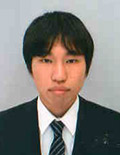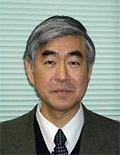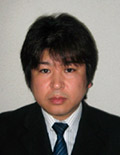Newsletter 2014.1 Index
Theme : "The Conference of Fluid Engineering Division"
| Back | |
Concentration statistics near the turbulent / non-turbulent interface of a planar liquid jet with a chemical reaction
Takahiro NAITO |
Abstract
We measure concentrations of reactive species near the turbulent/non-turbulent (T/NT) interface of a planar liquid jet with a second-order chemical reaction (A + B → R). The reactants A and B are premixed into the jet and ambient flows, respectively. A non-reactive dyestuff is also premixed into the jet. We use optical fiber probes based on the light absorption spectrometry to measure the concentrations of the reactive species. We investigate the two types of interfaces perpendicular to the streamwise direction: leading edge, across which the turbulent fluid turns into the non-turbulent fluid toward streamwise direction, and trailing edge, across which the non-turbulent fluid turns into the turbulent fluid toward streamwise direction. We use the concentration of the non-reactive dyestuff premixed into the jet as a turbulence indicator. For detecting the T/NT interfaces, we use the two optical fiber probes which are set next to each other in the cross-streamwise direction. We analyze the conditional statistics conditioned on the time elapsed from the time when the interface is detected.
The results show that the conditional statistics of the concentrations vary drastically near the T/NT interface, and the variations in the conditional statistics near the leading edge are larger than those near the trailing edge. The width of the interface with the large variation in the conditional mean concentration near the T/NT interface is almost independent of the chemical species and the Damkohler number. Because most of the reactant A is contained in the turbulent region, the chemical reaction takes place in the turbulent region. It is also found that the chemical reaction rate near the leading edge is larger than that near the trailing edge.
Key words
Jet, Chemical Reaction, Turbulent/non-turbulent Interface, Mixing, Turbulent Flow
Figures

Fig. 1 Snapshot of reactive planar liquid jet.

Fig. 2 Schematic diagram of the T/NT interface of a jet.

Fig. 3 Conditional mean concentrations at x/d = 20.

Fig. 4 Conditional mean chemical reaction rate.







